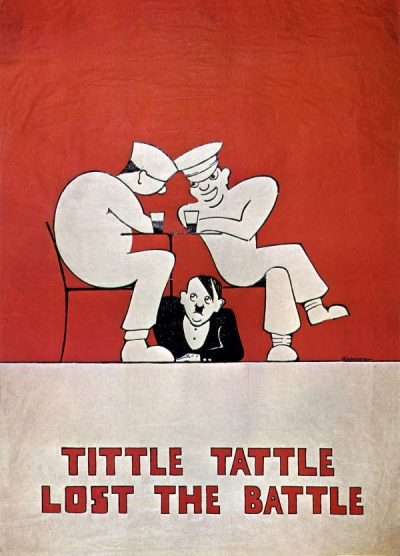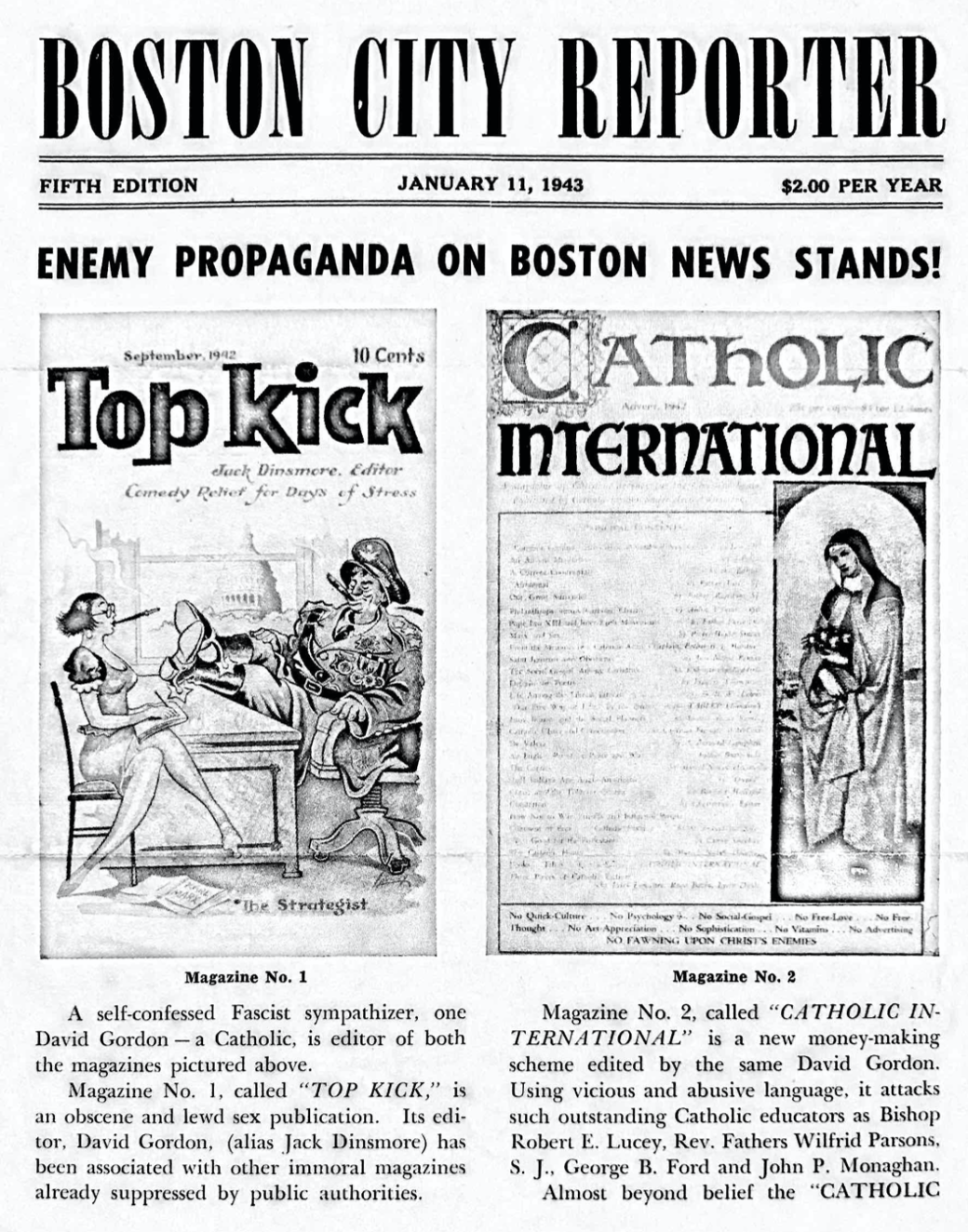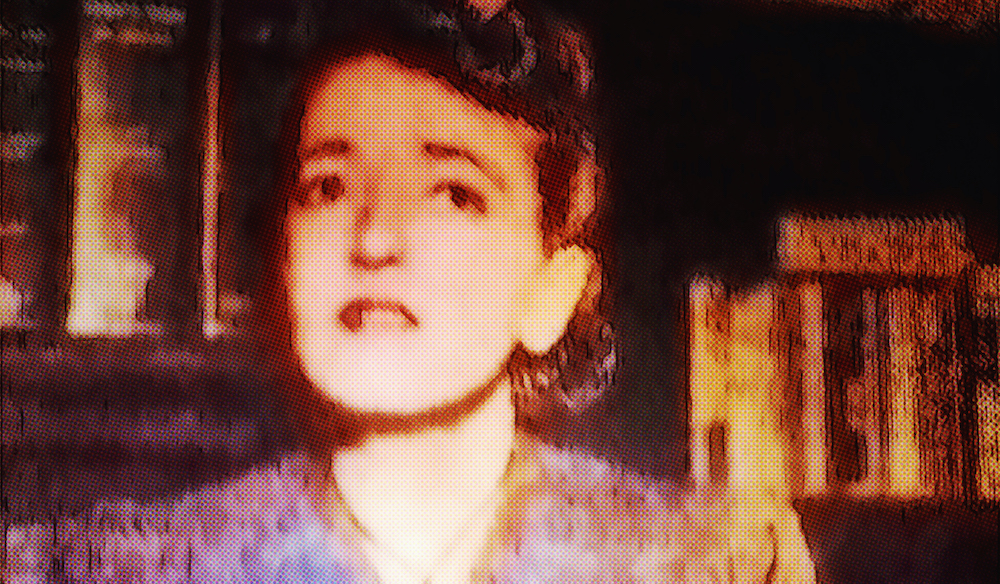“The object of The Boston City Reporter [was] to tell the public who is using prejudice against entire races and religions for undemocratic purposes—and how.”
On the Sunday before St. Patrick’s Day in 1942, Frances Sweeney stood among the horde waiting at South Boston High School for Father Edward Curran to speak as part of the city’s annual Evacuation Day festivities.
Unlike the other people in the room, Sweeney, a small-framed 34-year-old Irish Catholic woman from Brighton, had been publicly trashing Curran and calling for protests in local newspapers over the previous week.
Curran was head of a Brooklyn-based offshoot of the defunct Christian Front, which was inspired by hate radio architect Father Charles Coughlin. The notorious Coughlin, who had an estimated 40 million listeners, had called for the United States to stay out of World War II and was blaming the hostilities in Europe on people of Jewish descent. After 17 members in New York were arrested in January 1940 for an alleged terrorism plot, Christian Front chapters everywhere disbanded.
The crowd in Southie swelled to about 3,500, with approximately 40 cops on hand to keep people in check. According to an account in the Boston Herald, those who couldn’t fit inside the school building listened from outside in the parking lot on loudspeakers.
Like an environmentalist or Black Lives Matter activist crashing a Trump rally, Sweeney hoped to get into a prime position from which she could heckle Curran in person. She didn’t get the chance, though, as a pair of goons, who claimed to act on behalf of the hosting South Boston Citizens Association, grabbed her, dragged her from the press table, and ejected Sweeney from the room.
“As he took her arm to lead her down the aisle, nearly 2,000 persons in the auditorium arose and applauded,” the Herald reported. “Some of them waved flags.”
Association leaders later denied tapping a “roving commission” to regulate the crowd. Still, no one attempted to stop them from manhandling Sweeney.

Shame and fury
Though barely in her 30s when Adolf Hitler’s Third Reich began attacking its European neighbors, Sweeney campaigned against anti-Semitism, exposed fascism, battled fake news and Nazi propaganda, and inspired a generation of anti-racist activists.
“Frances Sweeney was an amateur in combating prejudice, as were some of the best workers in the field of human relations in those days,” Isabel Currier, one of Sweeney’s longtime friends, wrote in an obituary for the liberal American Catholic journal Commonweal Magazine. Currier described Sweeney as fragile, blond, and bright-eyed, “partly with enthusiasm and partly with the fatigue that fevers the physically frail.”
“She made a few errors through impulsiveness, mistaken judgment, misplaced confidence, and treading on toes—as most of us do, even after earning professional status in human relations, through years of experience,” Currier wrote.
Born in 1908, Sweeney was the only daughter of Frances and James Sweeney, the latter a bar owner in Brighton. She graduated from St. Joseph’s Academy, then went on to work for an advertising agency as a young woman. There is little information readily available on Sweeney’s background, which is not surprising considering how little is known of her grander accomplishments.
Sweeney was a political activist first and foremost. In 1941, she organized the first meeting of the American-Irish Defense Association, which was intended to motivate Irish Catholics to stand up against the fascist ideologies that consumed Europe during World War II. Ironically, that meeting took place at Faneuil Hall on Dec 7, the day that Japanese bombers hit Pearl Harbor, driving the United States into the war.

With news of the attack on the naval base circulating, Sweeney found her organizational attempts thwarted by thugs. Facing an audience that included about 100 members of the Christian Front, who were disgusted that she wasn’t blaming Jewish people for Pearl Harbor, Sweeney refused to back down. As Currier later recalled, “As one man they rose up and walked out of the meeting in a body, leaving Frances at a pitch of shame and fury.”
On the heels of that contentious effort, Sweeney figured she could make a bigger impact through journalism. For starters, she convinced the Herald to cover the remnants of a local Christian Front chapter.
The original Christian Front was founded in New York City in 1938, inspired by Father Coughlin’s call for a “crusade” against “anti-Christian forces of the Red Revolution.” Coughlin, an archetypal Rush Limbaugh-like figure whose biographer called him the “Father of Hate Radio,” equated communists with Jewish people as a means to demean both. On his watch, independent chapters of the Christian Front sprang up nationwide, including in extremely anti-Semitic Boston.
“In New York, where it reached the most advanced stage, the new anti-Semitism has been a domestic storm-troop mob running amuck, spewing racial hatred, fomenting violence, staging street scenes never before witnessed in the city’s history,” Theodore Irwin, an investigative pamphleteer, wrote in 1940.
Among his evil deeds, Coughlin inspired Irish Catholic teens to make frequent trips to predominantly Jewish neighborhoods—in Boston, Mattapan, Roxbury, and Dorchester—to assault residents.
“OCD [Office of Civil Defense] air raid wardens and auxiliary police are patrolling the streets at night to protect the children of Dorchester from attacks by gangs of young anti-Semitic hoodlums who rove the area apparently unmolested by police or local officials,” one Manhattan reporter wrote.
Sweeney had tipped off that New York journalist about the conditions in Boston. Meanwhile, at home, she pushed the Herald—conservative back then, not unlike its stance today—to cover the Christian Front and its Boston leader, Francis Moran.
As a result of that Herald coverage, the Boston Police Department commissioner demanded that the local Christian Front chapter be disbanded. Moran obliged, claiming that he chose to break up the group himself, as a gesture of goodwill.
In reality, he had been publicly shamed into oblivion. He wouldn’t be the last.

Revolutionary clinics
It’s easy to imagine the media climate and general frenzy jolting the US during the second World War—just think about the current state of things. To combat prevalent and dangerous fake news, Sweeney suggested that the Herald form what would eventually become known as the Rumor Clinic, a weekly column that dispelled propaganda that might harm the war effort. Like the television show MythBusters, but with much higher stakes.
Run out of the Herald, the Rumor Clinic was assisted by Harvard University researcher Robert Knapp and the state’s Division of Propaganda Research. Set up by the Massachusetts Committee on Public Safety, the special propaganda unit supervised “a listening network of 300 ‘morale wardens’—bartenders, waitresses, union representatives and insurance salesmen,” according to the Massachusetts Historical Society. And then there was Sweeney, who specialized in tracking down the sources of the rumors.
The column launched on March 1, 1942. In their first outing, the posse impugned a series of myths pertaining to blood donations. Among other damaging falsehoods, rumors were spreading that the Red Cross lacked the shipping capabilities to get donated blood to the front lines in Europe, making it a waste to donate, and that white soldiers who were given Black blood had Black children. As Dr. Carl Walter of Harvard Medical School explained in the inaugural column:
Scientifically, there is no difference between blood from the white or colored person and rumors that a white man will have colored children or a colored man have white children as a result of plasma transfusions from donors of another race are just as ridiculous today as a statement made a century ago that recipients receiving blood from goats would develop horns.
One column addressed fake news about Axis forces sinking ships along the coast of Cape Cod and occupying Boston Harbor islands. Some of the gossip that the Rumor Clinic tracked may sound naive from a contemporary standpoint, but not if you consider how many Americans believe the COVID-19 pandemic is political theater, that the Earth is flat, or that the Holocaust is a hoax.
Another rumor that Sweeney’s team gutted sought to undermine the growing female workforce, claiming that the heads of women with certain hair treatments might explode on job sites. From an August 1942 column:
The health guards established in establishments where women help to make explosives require that their hair be covered completely by overall turbans or bandanas, that they wear special clothing, freshly laundered, supplied to them at the beginning of each shift, and that they bathe thoroughly after each shift.
In just a few months, the Rumor Clinic took off, with newspapers in other cities even starting their own versions. Sweeney was favorably profiled in Readers Digest and Life Magazine, among other places, highlighting her anti-fascist work front and center. The attention brought jeers and fears as well as cheers, though, and eventually the Herald caved in to its conservative audience and the federal government, which went after rumor clinics and their writers with a vengeance.
According to the New England Historical Society, “The [US Office of War Information] went to war with the local Rumor Clinics. It established stringent criteria for getting federal funding and tried to bury them in red tape. The OWI condemned the rumor clinics in a 1943 New York Times story, claiming the attempts to spike rumors actually spread them. The Rumor Clinics went into a decline and were gone by war’s end.”

Myth busters
Shown the door at the Herald, Sweeney launched the Boston City Reporter in late 1942. In the form of a monthly four-page mimeographed newsletter, Sweeney used each issue to attack a specific corrupt or bigoted person or organization. Her staff mailed the newsletter to thousands of homes in predominantly Irish neighborhoods in Boston and also had a paid subscriber base to help fund the operation.
“The object of The Boston City Reporter is, and always has been to tell the public who is using prejudice against entire races and religions for undemocratic purposes—and how,” Currier wrote years later in a recap of the newsletter’s history. “We quote the public sayings and public writing of these people, which are spoken and written to lure other people into hatred of their fellowmen.”
Sweeney’s debut issue targeted John J. Murphy, publisher of Save America Now, a conservative magazine based in Boston. Murphy published anti-Semitic rumors that were toxic enough for the Ku Klux Klan to reprint in its own propaganda pages, making him a prime candidate to examine.
The Boston City Reporter was also focused on helping the war effort, and in its third issue debunked a rumor spread by the state’s Department of the American Legion that Jewish people were more likely to dodge the draft. The reality, which Sweeney showed using irrefutable military data, was that as a percentage of their total share of the American population, Jewish people were joining the military at higher rates than other racial or religious groups.
After releasing only five issues, Sweeney set her sights on the publisher of Catholic International, an outlet featuring political commentary that was sympathetic to Nazi ideals and anti-Semitic sentiment, and scored one of her biggest wins. In addition to exposing publisher David Gordon as a fascist, the Boston City Reporter revealed that the alleged man of Catholic faith had also secretly printed an adult rag that specialized in dirty cartoons.
“Almost beyond belief the ‘Catholic International’ brazenly attempts to undermine our faith in our government, our allies, and in the usual Nazi manner, our fellow-Americans of Jewish faith,” Sweeney wrote in a Jan. 11, 1943, report. The same week, Hitler bolstered his army, enlisting 500,000 male factory workers in preparation for further expansion. In that climate, and with pressure from Sweeney, Boston’s newsstands banished Catholic International.
“Gordon has the arrogance to include articles advising Catholics concerning marriage and sex,” Sweeney wrote in her piece. “Such advice on the part of a former sex-magazine editor is certainly gross and monstrous.”
In his investigation into creeping fascism across the country, culminating in the 1943 book Undercover, famed journalist John Roy Carlson (a pen name of Arthur Derounian) praised Sweeney for the Gordon takedown.
“Almost singlehandedly Miss Sweeney succeeded in barring from the large newsstands copies of Catholic International, a near-seditious organ berating our war effort, defaming Democracy and championing clerical fascism,” Carlson wrote.

Unsung
On the one-year anniversary of her harsh ejection from a South Boston Citizens Association event, Sweeney dedicated a whole issue of the Boston City Reporter to roasting the Evacuation Day speakers at the 1943 banquet. Father Curran had been reinvited, and Sweeney’s feelings toward him hadn’t softened in the months since she was tossed.
“From the moment he arrived in Boston, when he fondly greeted Francis Moran, director of the police-closed Christian Front until he closed his speech with a prayer ‘as an American for an American victory,’ he peddled Old World hates and sang Hitler’s merrie tune,” Sweeney wrote. “Father Curran, along with other bitter nationalists, have failed to see the issues of this conflict. Blinded by conceit, bewildered by events beyond the scope of little minds, he still sings his hymns of hate and spreads confusion and distrust.”
It was one thing to hold individuals accountable. Sweeney, however, was starting a movement far beyond her personal adversaries and in her sixth issue called readers to action: “The hands move forward on the clock of Fascism whenever such outbreaks go uncondemned by the democratic forces. What are YOU doing?”
To advance the Boston City Reporter’s mission and expand its reach and impact, Sweeney organized a group of teenagers—ambitious, aspiring reporters—to help her track down dirt. One of those young people was Nat Hentoff, who eventually became a well-known author and columnist for the Village Voice in New York. In his memoir, Boston Boy, which he dedicated to Sweeney, Hentoff recalled the Irish brutes who used to beat and threaten him and his Jewish friends in Grove Hall.
“What I want from you is facts,” Hentoff remembered Sweeney saying; he wrote that she was the first person to teach him about journalism. “A fact is something that can be proved, and you will bring me proof with each fact you bring me. Anything that is not a fact is an opinion. I do not want your opinions. In this newspaper, only the editor has opinions, but they are of no use unless they are based on facts.”
About a year after she launched the Boston City Reporter, Sweeney tipped off the newspaper New York PM about chronic physical assaults on Jewish people in Boston. The subsequent report, for which Sweeney obtained 14 affidavits, led to then-Massachusetts Gov. Leverett Saltonstall creating the Governor’s Committee for Racial and Religious Understanding, which eventually became the Massachusetts Commission Against Discrimination.
Sweeney accomplished a lot in a short time. Perhaps she knew that she had to. At an early age, she learned that she had serious health complications; according to her death certificate, Sweeney was diagnosed with rheumatic heart disease at age 10, which often develops from untreated strep throat, permanently weakening the heart’s valves.
As Hentoff told it, one night in April 1944, Sweeney was walking along Beacon Street in Brookline when she suffered a heart attack. She told her mentee that she spent several hours in a gutter, unable to get up, before a police officer finally helped. Passersby assumed that she was a drunken vagrant.
Sweeney never fully recovered and died on June 19, 1944, at 36 years old. She only completed 10 issues of the Boston City Reporter, but a group of her friends and supporters formed the Frances Sweeney Committee and continued publishing the paper into the ’50s.
Months after her death, Sweeney was posthumously awarded the Pope Leo XIII Award by Bishop Bernard Sheil in Chicago, in honor of her work against racism and fascism. It’s one of the few recorded public recognitions of a hero whose efforts should resonate in current conversations about challenging intolerance.
Some even predicted that the revolutionary journalist would be forgotten. In a letter published in the Boston Globe six months after her passing, a friend and admirer named David Weisman called Sweeney the “most inspiring Irish Catholic friend I have ever had” and questioned if the residents of Boston deserved her fearless efforts.
“A girl war hero as worthy as any Soviet guerrilla girl or Yugoslav girl-soldier, the late Frances Sweeney, is still unsung and unhonored in her native Boston,” Weisman wrote.
“Why?”









